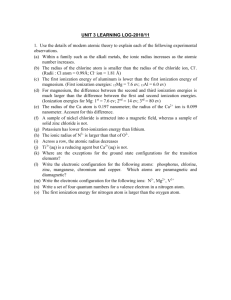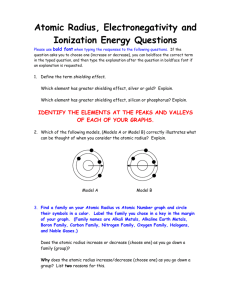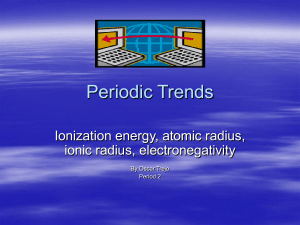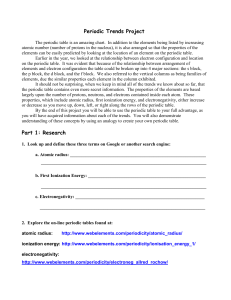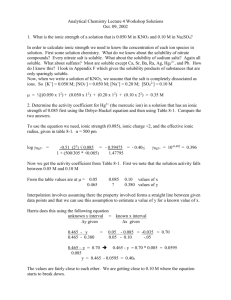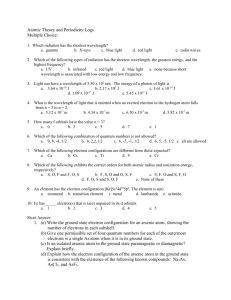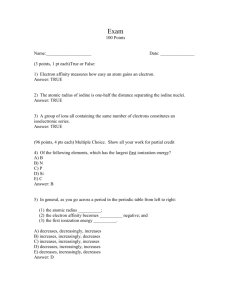6 Chemical Periodicity - Fort Bend ISD / Homepage
advertisement
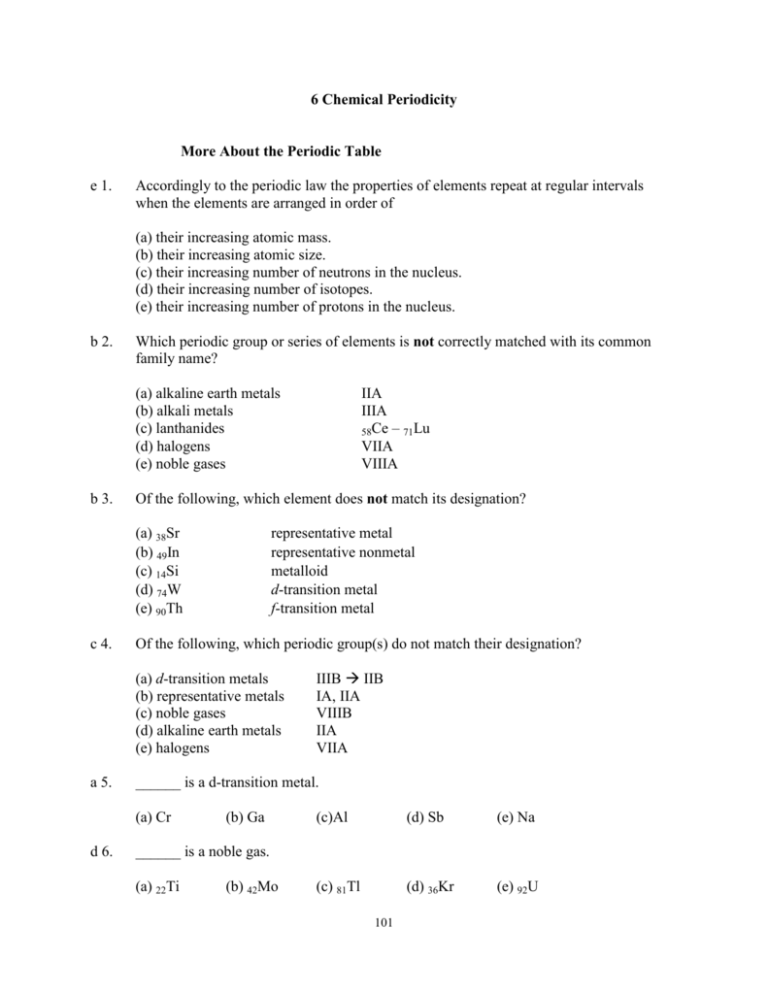
6 Chemical Periodicity More About the Periodic Table e 1. Accordingly to the periodic law the properties of elements repeat at regular intervals when the elements are arranged in order of (a) their increasing atomic mass. (b) their increasing atomic size. (c) their increasing number of neutrons in the nucleus. (d) their increasing number of isotopes. (e) their increasing number of protons in the nucleus. b 2. Which periodic group or series of elements is not correctly matched with its common family name? (a) alkaline earth metals (b) alkali metals (c) lanthanides (d) halogens (e) noble gases b 3. Of the following, which element does not match its designation? (a) 38Sr (b) 49In (c) 14Si (d) 74W (e) 90Th c 4. representative metal representative nonmetal metalloid d-transition metal f-transition metal Of the following, which periodic group(s) do not match their designation? (a) d-transition metals (b) representative metals (c) noble gases (d) alkaline earth metals (e) halogens a 5. IIIB IIB IA, IIA VIIIB IIA VIIA ______ is a d-transition metal. (a) Cr d 6. IIA IIIA 58Ce – 71Lu VIIA VIIIA (b) Ga (c)Al (d) Sb (e) Na (c) 81Tl (d) 36Kr (e) 92U ______ is a noble gas. (a) 22Ti (b) 42Mo 101 102 e 7. ______ is an actinide. (a) 22Ti b 8. (b) Ho (b) Sr II. 42Mo (a) I and II (d) IV and V (d) Ru (c) Ni (d) K III. 81Tl IV. 36Kr (b) II and III (e) I, III, and V (b) ns2np2 (e) Bi (e) N V. 92U (c) III and IV (c) ns2np4 (d) np6 (e) ns0np6 What would be the outer electron configuration of group IIIB (Sc, Y, La . . .)? (b) nd1ns2 (e) (n-1)d1ns2 (a) ns2nd2np0 (d) ns1np3 e 13. (c) Co What would be the outer electron configuration of group VIA (O, S, Se, . . .)? (a) ns2np6 e 12. (e) 92U Choose the response that includes all of the listed elements that are d-transition elements, and no others. I. 22Ti c 11. (d) 36Kr Which of the following is not a representative element? (a) Cl a 10. (c) 81Tl Which one of the following is an inner transition (f-transition) element? (a) Rb c 9. (b) 42Mo (c) ns2(n-1)d1 What would be the outer electron configuration of alkaline earth metals? (a) ns2np2 (b) np2 (c) ns0np2 (d) nd2 (e) ns2 b 14. What would be the outer electron configuration of halogens? (a) ns2np6 b 15. (b) ns2np5 (c) ns2np7 (d) ns2np4 (e) ns2nd5np0 Choose the term that best describes all members of this series of elements: Xe, Rn, He, Ne, Kr (a) metalloids (d) alkali metals (b) noble gases (e) representative elements (c) alkaline earth metals Chapter 6 103 e 16. Choose the term that best describes all members of this series of elements: K, Ca, Ba, Cl, N (a) metalloids (d) alkali metals (b) d–transition elements (e) representative elements (c) alkaline earth metals Atomic Radii e 17. Which of the following statements is false? (a) (b) (c) (d) (e) a 18. Which element has the largest atomic radius? (a) Al e 19. (b) Si (c) P (d) S (e) Cl Which element has the largest atomic radius? (a) B a 20. The effective nuclear charge experienced by an electron in an outer shell is less than the actual nuclear charge. Within a family (vertical group in the periodic table) of representative elements atomic radii increase from top to bottom. Electrons in inner shells screen, or shield, electrons in outer shells from the full effect of the nuclear charge. The atomic radii of representative elements decrease from left to right across a period (horizontal row in the periodic table). Transition elements have larger atomic radii than the preceding IA and IIA elements in the same period because transition elements have electrons in their d orbitals. (b) Al (c) Ga (d) In (e) Tl Which element has the largest atomic radius? (a) Cs (b) Ba (c) Tl (d) Pb (e) Bi b 21. Which element has the largest atomic radius? (a) Ga c 22. (c) Ge (d) P (e) O Which element has the largest atomic radius? (a) 3Li c 23. (b) In (b) 11Na (c) 37Rb (d) 9F (e) 53I Which element has the largest atomic radius? (a) F (b) Cl (c) Sn (d) Kr (e) Se 104 b 24. Which element has the largest atomic radius? (a) Ca e 25. (c) 11Na (d) 28Ni (e) 37Rb (b) Mg (c) Al (d) Si (e) P (b) Cl (c) Br (d) I (e) At (b) Au (c) Bi (d) In (e) Te (d) Mg (e) Cl Which element has the smallest radius? (a) K e 30. (b) 16S Which element has the smallest radius? (a) Mo e 29. (e) Na Which element has the smallest radius? (a) F e 28. (d) P Which element has the smallest radius? (a) Na a 27. (c) Cr Which element has the largest atomic radius? (a) 9F e 26. (b) Sr (b) Na (c) Rb Arrange the following elements in order of increasing atomic radii. Sr, Rb, Sb, I, In (a) Rb < Sr < In < Sb < I (c) In < Sb < I < Sr < Rb (e) I < Sb < In < Sr < Rb (b) I < Sb < In < Rb < Sr (d) Sb < I < In < Sr < Rb b 31. Arrange the following elements in order of increasing atomic radii. K, Na, Mg, Cs, Cl (a) Na < Mg < Cl < K < Cs (c) Cs < K < Cl < Mg < Na (e) Cl < Mg < Na < Cs < K c 32. (b) Cl < Mg < Na < K < Cs (d) Cl < Mg < Cs < K < Na Arrange the following elements in order of decreasing atomic radii. Pb, P, Cl, F, Si (a) Cl > F > Pb > Si > P (c) Pb > Si > P > Cl > F (e) Pb > Cl > P > Si > F (b) Pb > Si > P > F > Cl (d) Pb > Cl > P > Si > F Chapter 6 105 Ionization Energy a 33. The minimum energy required to remove the most loosely held electron is (a) (b) (c) (d) (e) first ionization energy. electron affinity potential energy kinetic energy electronegativity. b 34. The first ionization energy of sulfur is less than that of phosphorus. A reasonable explanation for this fact involves (a) the stability of the half-filled subshell in atomic sulfur. (b) pairing of two electrons in one 3p orbital in sulfur atoms. (c) the smaller size of sulfur atoms relative to phosphorus atoms. (d) the ease with which phosphorus attains a noble gas electronic configuration. (e) the higher electronegativity of sulfur relative to phosphorus. e 35. Which element has the lowest first ionization energy? (a) F a 36. (c) Br (d) I (e) At Which element has the lowest first ionization energy? (a) Cs e 37. (b) Cl (b) Rb (c) Ca (d) Ba (e) Na Which element has the lowest first ionization energy? (a) F (b) B (c) O (d) S (e) Sr b*38. Which element has the lowest first ionization energy? (a) Be a 39. (d) N (e) O (b) Al (c) Ga (d) In (e) Tl Which element has the highest first ionization energy? (a) Sn e 41. (c) C Which element has the highest first ionization energy? (a) B e 40. (b) B (b) Cd (c) As (d) Tc (e) Cl Which element has the highest first ionization energy? (a) Li (b) Cs (c) Cl (d) I (e) Ar 106 d 42. Which element has the highest first ionization energy? (a) Be (b) B (c) C (d) N (e) O a*43. Arrange the following elements in order of increasing first ionization energy. Mg, Al, Si, P, S (a) Al < Mg < Si < S < P (c) Al < Mg < Si < P < S (e) Al < Mg < P < Si < S (b) Mg < Al < Si < P < S (d) Mg < Al < Si < S < P d 44. Arrange the following elements in order of decreasing first ionization energy. Rb, In, Sn, Sb, As (a) Sb > Sn > In > As > Rb (c) Rb > As > Sb > Sn > In (e) As > Sn > Sb > In > Rb (b) As > In > Sn > Sb > Rb (d) As > Sb > Sn > In > Rb b 45. Arrange the following elements in order of decreasing first ionization energy. Be, Ca, Cs, Mg, K (a) Mg > Be > Ca > K > Cs (c) Cs > K > Ca > Be > Mg (f) Ca > Mg > Be > K > Cs (b) Be > Mg > Ca > K > Cs (d) Ca > Mg > Be > Cs > K c *46. Arrange the following elements in order of decreasing first ionization energy. F, Be, O, N, C (a) F > O > N > C > Be (c) F > N > O > C > Be (e) Be > C > N > O > F (b) Be > C > O > N > F (d) O > F > N > Be > C Electron Affinity c 47. The amount of energy absorbed in the process in which an electron is added to a neutral gaseous atom is defined as _____. (a) shielding effect (d) first ionization energy c 48. (b) electronegativity (c) electron affinity (e) standard reduction potential Which of the following elements has the most negative electron affinity? (a) Si (b) P (c) S (d) Se (e) Te Chapter 6 107 d 49. Which of the following elements has the most negative electron affinity? (a) As (b) Al (c) K (d) Se (e) Sn d 50. The general electron configuration for the element group that would have the largest negative value for the electron affinity for its atoms is ________? (a) ns2np6 e 51. (b) ns2np4 (c) ns1 (d) ns2np5 (e) ns2np3 Arrange the following elements in order of increasing values of electron affinity, i.e., from most negative to least negative. (Note: None of these elements is an exception to the general trends of electron affinities.) Cl, Se, S, Cs, Rb, Te (a) Cl < S < Se < Rb < Te < Cs (c) Cl > Se > S > Te > Rb > Cs (e) Cl < S < Se < Te < Rb < Cs (b) Cl > Te > Se > S > Rb > Cs (d) Cl < S < Se < Te < Cs < Rb Ionic Radii d 52. Which one of the following species is not isoelectronic with neon? (a) Mg2+ e 53. (b) Na+ (c) O2– (d) Cl– (e) Al3+ Which one of the following pairs contains isoelectronic species? (a) Na, Na+ (d) F2, Cl2 (c) S2–, Se2– (b) S, Se (e) Na+, O2– b 54. Which of the following ions is not isoelectronic with the others? (a) I- (b) Sb3+ (c) Te2- (d) Ba2+ (e) Cs+ b 55. Which of the following ions is not isoelectronic with a noble gas? (a) Mg2+ e 56. (c) Cs+ (d) Se2– (e) Ba2+ (d) Te2– (e) Po2– (d) I– (e) At– Which ion has the largest radius? (a) O2– e 57. (b) P2– (b) S2– (c) Se2– Which ion has the largest radius? (a) F– (b) Cl– (c) Br– 108 b 58. Which ion has the largest radius? (a) Li+ (b) Na+ (c) Be2+ (d) Mg2+ (e) Al3+ c*59. Consider the group of ions that are isoelectronic with krypton. Which response contains all the true statements and no others? I. The ion with the highest positive charge is the largest ion. II. The ion with the highest atomic number bears the highest positive charge. III. The ion with the lowest atomic number bears the least negative charge. IV. The ion with a 1– charge is obtained by adding one electron to a Group VIIA element. V. All the ions have a noble gas electronic configuration. (a) II and III (d) I and IV a 60. (b) Cl– (c) Br– (d) I– (e) At– (d) Te2– (e) Po2– Which ion has the smallest radius? (a) O2– e 62. (c) II, IV, and V Which ion has the smallest radius? (a) F– a 61. (b) I, II, and V (e) II, III, IV, and V (b) S2– (c) Se2– Which ion has the smallest radius? (a) As3– (b) Se2– (c) Br– (d) Rb+ (e) Sr2+ e*63. Which ion has the smallest radius? (a) K+ (b) Cs+ (c) Sr2+ (d) Ba2+ (e) Tl3+ (d) Se2– (e) Br d 64. Which ion or atom has the largest radius? (a) S e 65. (b) S2– (c) Se Which ion or atom has the largest radius? (a) Sr2+ (b) Rb+ (c) Kr (d) Br– (e) Se2– b 66. Arrange the following set of ions in order of increasing ionic radii. Ca2+, Cl–, K+, P3–, S2– (a) Ca2+ < K+ < P3– < S2– < Cl– (c) K+ < Cl– < Ca2+ < S2– < P3– (e) P3– < S2– < Cl– < K+ < Ca2+ (b) Ca2+ < K+ < Cl– < S2– < P3– (d) Cl– < S2– < P3– < Ca2+ < K+ Chapter 6 109 e 67. Arrange the following set of ions in order of decreasing ionic radii. Al3+, Ga3+, Ca2+, Rb+, K+ (a) Rb+ > Ga3+ > Ca2+ > K+ > Al3+ (c) Ga3+ > Al3+ > Ca2+ > Rb+ > K+ (e) Rb+ > K+ > Ca2+ > Ga3+ > Al3+ (b) Rb+ > K+ > Ca2+ > Al3+ > Ga3+ (d) Rb+ > Ca2+ > K+ > Ga3+ > Al3+ d 68. Which of the lists of increasing ionic radii is not correct? (a) Cl– < Br – < I– (d) S2– < Cl– < K+ c 69. (b) Al3+ < Mg2+ < Na+ (e) Na+ < O2– < N3– (c) Ca2+ < Sr2+ < Ba2+ Which of these comparisons according to radius is (are) correct? I. Na+ > Mg2+ (a) I and II II. In3+ > Sr2+ (b) II and IV (c) I and III III. Cl– > K+ IV. Cl > K (d) II and III (e) III and IV Electronegativity e 70. A property that measures the ability of an atom to attract electrons in a chemical bond is (a) binding energy. (d) ionization energy. e 71. (d) K (e) Cs (b) Na (c) Rb (d) Y (e) Sc (b) Ca (c) Ga (d) Ge (e) As Which element has the lowest electronegativity? (a) P a 75. (c) Na Which element has the lowest electronegativity? (a) K c 74. (b) Li Which element has the lowest electronegativity? (a) Mg a 73. (c) electron affinity. Which element has the lowest electronegativity? (a) H c 72. (b) mass defect. (e) electronegativity. (b) As (c) Sb (d) Te (e) I Which element has the highest electronegativity? (a) C (b) Si (c) Ge (d) Sn (e) Pb 110 b 76. Which element has the highest electronegativity? (a) 3Li (b) 7N (c) 19K (d) 33As (e) 56Ba d 77. Which element has the highest electronegativity? (a) B a 78. (c) Ca (d) O (e) At Which element has the highest electronegativity? (a) N c 79. (b) Ge (b) Si (c) As (d) P (e) C Arrange the following elements in order of increasing electronegativities. At, Bi, Cl, F, I (a) At < Bi < Cl < F < I (d) F < Cl < I < At < Bi a 80. (b) F < Cl < Bi < I < At (e) At < Bi < I < Cl < F (c) Bi < At < I < Cl < F Arrange the following elements in order of decreasing electronegativities. Al, Cs, Mg, Na, P (a) P > Al > Mg > Na > Cs (c) Al > Mg > Na > Cs > P (e) P > Cs > Na > Mg > Al (b) Cs > Na > Mg > Al > P (d) P > Al > Mg > Cs > Na b 81. Which comparison of electronegativities is not correct? (a) Br > Se e 82. (b) K > Mg (c) O > S (d) N > Be (e) I > Ba Which comparison of electronegativities is not correct? (a) Ge > Ga (b) Ba > Cs (c) O > N (d) F > Cl (e) B > C d 83. Which of the these elements has the greatest attraction for electrons in a covalent bond? (a) Ge c 84. (b) As (c) Se (d) Br (e) Kr Which of the following pairs of elements would be expected to form an ionic compound? (a) S, F (b) H, C (c) Rb, Cl (d) As, Br (e) C, I b 85. Which pair of elements below would be least likely to form an ionic bond between them? (a) Na and S (d) Mg and Br (b) C and N (e) Cs and O (c) Al and F Chapter 6 111 e 86. Chlorine is most likely to form an ionic compound with ______. e 87. (a) F (b) O (c) C (d) N (e) Li Iodine is most likely to form an ionic compound with ______. (a) B (b) Si (c) Br (d) N (e) Mg Hydrogen and the Hydrides c 88. Which one of the following reactions does not produce H2(g)? (a) electrolysis of H2O (c) combustion of ethane, C2H6 (e) steam cracking of hydrocarbons (b) zinc with HCl(aq) (d) iron with steam d 89. Which of the following statements about hydrogen is false? (a) (b) (c) (d) (e) a 90. Hydrogen occurs as a diatomic molecule. Hydrogen can be produced by the reaction of an active metal and HCl(aq). NH3, the binary hydride of nitrogen, is called ammonia. Hydrogen forms only molecular compounds. Metal hydrides are basic. Which one of the following reactions is the "water gas" reaction? 1500C (a) C(s) + H2O(g) CO(g) + H2(g) (b) 2CH4(g) + 3O2(g) heat 2CO(g) + 4H2O(g) (c) CH4(g) + 2H2(g) catal yst C(s) (d) 2Na(s) + 2H2O(l) 2NaOH(aq) + H2(g) (e) C4H10(g) + 3H2(g) catal yst 2C2H2(g) d 91. Which pair of gases is the product of the “water gas reaction”? (a) H2O + H2 (d) CO + H2 c 92. (b) CO + H2O (e) H2 + O2 (c) O2 + H2O Which one of the following (pure) compounds of hydrogen is ionic? (a) HF (b) HCl (c) NaH (d) H2O (e) H2Se d 93. Which one of the following is an ionic hydride? (a) CH4 (b) H2Se (c) AsH3 (d) BaH2 (e) B2H6 112 b 94. Which of the following responses lists only the ionic hydrides? I. LiH (a) I II. B2H6 (b) I, V III. GeH4 (c) II, III IV. HCl (d) II, III, IV V. BaH2 (e) I, II, V d 95. Which one of the following is a molecular hydride? (a) RbH (b) SrH2 (c) NaH (d) PH3 (e) CaH2 b *96. Which of the following is incorrectly classified? (a) KH – ionic hydride (d) CsH – ionic hydride (b) CH4 – ionic hydride (c) HI – molecular hydride (e) H2S – molecular hydride d 97. Which response includes all the elements below whose compounds with hydrogen would be expected to be molecular hydrides, and no others? Br, K, P, B (a) K, B c 98. (b) Br, P (c) K, Br (d) Br, P, B (e) Br Which one of the following hydrides is basic? (a) H2Te (b) B2H6 (c) CaH2 (d) HI (e) CH4 d 99. Which one of the following hydrides is not acidic? (a) HF (b) HCl (c) H2S (d) CaH2 (e) H2Se d *100. What would be the general balanced equation for the reaction of the ionic hydride MH2 with excess water? (a) MH2(s) (b) MH2(s) (c) MH2(s) (d) MH2(s) (e) MH2(s) + + + + + H2O(l) H2O(l) H2O(l) 2H2O(l) 3H2O(l) MOH(aq) + H2(g) MO(s) + 2H2(g) MH2(s) + H2O(g) M(OH)2(aq) + 2H2(g) MO(s) + 4H2(g) + O2(g) a 101. Write the balanced formula unit equation for the reaction of nitrogen with hydrogen at high temperature and pressure. What is the sum of the coefficients? Don’t forget coefficients of one. Use the smallest whole number coefficients. (a) 6 (b) 7 (c) 8 (d) 4 (e) 5 Chapter 6 113 c 102. Write the balanced formula unit equation for the reaction of magnesium with hydrogen at high temperature. What is the sum of the coefficients? Don’t forget coefficients of one. Use the smallest whole number coefficients. (a) 5 (b) 6 (c) 3 (d) 4 (e) none of these a 103. Write the balanced formula unit equation for the reaction of magnesium with hydrochloric acid. What is the sum of the coefficients? Don’t forget coefficients of one. Use the smallest whole number coefficients. (a) 5 (b) 6 (c) 3 (d) 4 (e) none of these d 104. Write the balanced formula unit equation for the reaction of zinc with dilute sulfuric acid, H2SO4. What is the sum of the coefficients in the balanced equation? Use the smallest whole numbers possible. Don't forget coefficients of "one". (a) six (b) seven (c) eight (d) four (e) five b 105. Write the balanced formula unit equation for the reaction of sodium hydride with water. What is the sum of the coefficients in the balanced equation? Use the smallest whole numbers possible. Don't forget coefficients of "one". (a) three (b) four (c) five (d) six (e) eight Oxygen and the Oxides b 106. Oxygen was discovered by Priestley in 1774 when he observed the _________. (a) electrolysis of water (b) thermal decomposition of mercury(II) oxide, HgO (c) reaction of sulfuric acid, H2SO4, with sodium (d) results of fractional distillation of air (e) the thermal decomposition of potassium chlorate, KClO3 e 107. Which of the following statements about oxygen is false? (a) (b) (c) (d) (e) The most common form of oxygen is a diatomic molecule. Ozone is an allotrope of oxygen. Both ozone and oxygen are oxidizing agents. Oxygen forms binary compounds with nonmetals called acid anhydrides. Oxygen forms basic nonmetal oxides. a 108. Which one of the following will not react with oxygen to form a peroxide? (a) Be (b) Ca (c) Sr (d) Ba (e) all form peroxides 114 c 109. Which statement does not accurately describe ozone? (a) (b) (c) (d) (e) Its molecules are angular. Its density is about 1 12 times that of O2. Its two oxygen – oxygen bond lengths are 1.23 Å and 1.48 Å. It is unstable. It is a very strong oxidizing agent. d 110. Which of the following anions represents a peroxide? (a) O- (b) O2- (c) O2- (d) O22- (e) O3- c 111. Which one of the following compounds is a superoxide? (a) Na2O2 (b) SrO (c) KO2 (d) Li2O (e) Cl2O7 c 112. What is the principal product of the reaction of sodium with oxygen? (a) NaO (b) Na2O (c) Na2O2 (d) NaO2 (e) Na2O3 a 113. Which one of the following does not represent correctly the major product formed by the reaction of an alkali metal with oxygen at ordinary temperatures and pressures? (a) Li2O2 (b) Na2O2 (c) KO2 (d) RbO2 (e) CsO2 a 114. Which of the following statements about binary oxides is false? (a) (b) (c) (d) (e) Basic oxides are molecular. Some oxides like BeO are amphoteric. Nonmetal oxides are usually acidic. Metal oxides are usually basic. Acid anhydrides are molecular. c 115. Which response includes all the oxides below that are ionic and none that are molecular? I. Na2O (a) II and IV (d) III and IV II. CaO III. As2O5 (b) I, II, and III (e) II and III IV. SO3 (c) I and II e 116. Which response contains all the basic oxides listed below and no others? I. NO (a) I and IV (d) IV and V II. CaOIII. Li2O IV. SO2 (b) II and IV (e) II and III V. P4O10 (c) I, III, and IV Chapter 6 115 c 117. Which response includes all of the following oxides that are basic anhydrides and no others? I. N2O II. P4O6 III. CaO IV. OF2 (a) I and II (b) II (c) III (d) IV (e) III and IV b 118. Which response includes all the oxides below that are molecular and none that are ionic? I. K2O II. B2O3 III. N2O5 IV. N2O3 (a) I and IV (d) III and IV (b) II, III, and IV (e) I and II (c) II and III a 119. Which response includes all of the following oxides that are acid anhydrides? I. CO2 II. CaO III. ClO2 IV. Tl2O3 (a) I and III (d) II, III, and IV (b) II and IV (e) I (c) I and IV e 120. Which of the following oxides does not give an acidic solution when dissolved in water? (a) SO2 (b) CO2 (c) N2O5 (d) P4O10 (e) Na2O b 121. An amphoteric compound exhibits (a) acidic properties. (b) acidic and basic properties. (e) basic properties. (e) ionic properties. (c) metallic properties. b 122. Which one of the following oxides is amphoteric? (a) Li2O (b) BeO (c) CO2 (d) P4O6 (e) Cl2O d 123. Which of the following oxides is not amphoteric? (a) Al2O3 (b) BeO (c) SnO2 (d) Br2O7 (e) PbO2 d*124. One of the following oxides is insoluble in water. Which one? (a) CO2 (b) N2O5 (c) SO2 (d) SiO2 (e) SO3 e 125. Arrange the following in order of increasing ionic character (most ionic at right). BaO, SiO2, SO2 (a) BaO < SiO2 < SO2 (d) BaO < SO2 < SiO2 (b) SO2 < BaO < SiO2 (e) SO2 < SiO2 < BaO (c) SiO2 < SO2 < BaO 116 a 126. Arrange the following in order of decreasing basicity. MgO, Cs2O, Cl2O7, SnO2, P4O10 (a) Cs2O > MgO > SnO2 > P4O10 > Cl2O7 (b) MgO > Cs2O > P4O10 > SnO2 > Cl2O7 (c) Cs2O > SnO2 > MgO > P4O10 > Cl2O7 (d) MgO > Cs2O > SnO2 > P4O10 > Cl2O7 (e) Cl2O7 > P4O10 > SnO2 > Cs2O > MgO d 127. Arrange the following in order of increasing acidic character (most acidic at the right). Al2O3, Na2O, N2O5 (a) Al2O3 < Na2O < N2O5 (d) Na2O < Al2O3 < N2O5 (b) N2O5 < Al2O3 < Na2O (e) Na2O < N2O5 < Al2O3 (c) Al2O3 < N2O5 < Na2O c 128. Which one of the following compounds would be expected to react with oxygen at elevated temperatures to produce both an acidic oxide and a basic oxide? (a) CH4 (b) CS2 (c) CaS (d) NO (e) H2S d 129. The acid formed by dissolving Cl2O7 in water is __________. (a) HClO (b) HClO2 (c) HClO3 (d) HClO4 (e) HCl d 130. Write the balanced formula unit equation for the reaction of sodium with oxygen (use the major product). What is the sum of the coefficients? (a) 2 (b) 7 (c) 3 (d) 4 (e) 5 a 131. Write the balanced formula unit equation for the reaction of rubidium, Rb, with oxygen (use the major product). What is the sum of the coefficients? (a) 3 (b) 7 (c) 8 (d) 4 (e) 5 e 132. Write the balanced formula unit equation for the reaction of barium with a limited amount (low pressure) of oxygen. What is the sum of the coefficients? (a) 2 (b) 6 (c) 3 (d) 4 (e) 5 c 133. Write the balanced formula unit equation for the reaction of barium with an excess (high pressure) of oxygen. What is the sum of the coefficients? (a) 2 (b) 8 (c) 3 (d) 4 (e) 5 Chapter 6 117 e 134. Write the balanced formula unit equation for the reaction of copper with excess O2 at elevated temperatures. What is the sum of the coefficients? (a) 6 (b) 8 (c) 3 (d) 4 (e) 5 d 135. Which of the following metal oxides would not be expected to form under conditions of limited oxygen? (a) FeO (b) PbO (c) Cu2O (d) CrO3 (e) SnO b 136. Write the balanced formula unit equation for the reaction of arsenic, As4, heated with an excess of oxygen (The molecular formula for the product is the same as the empirical formula). What is the sum of the coefficients? (a) 7 (b) 8 (c) 3 (d) 4 (e) 5 c 137. Write the balanced formula unit equation for the reaction of barium oxide with water. What is the sum of the coefficients? (a) 6 (b) 8 (c) 3 (d) 4 (e) 5 d 138. Write the balanced formula unit equation for the reaction of lithium oxide with water. What is the sum of the coefficients? (a) 2 (b) 6 (c) 3 (d) 4 (e) 5 c 139. Lithium hydroxide is sometimes used to remove carbon dioxide from the atmosphere of disabled submarines. Write the balanced formula unit equation for this reaction if the products are lithium carbonate and water. What is the sum of the coefficients? (a) 7 (b) 6 (c) 5 (d) 4 (e) 8 d 140. Write the balanced formula unit equation for the reaction of dichlorine heptoxide with water. What is the sum of the coefficients? (a) 7 (b) 8 (c) 3 (d) 4 (e) 5 d 141. Write the balanced formula unit equation for the reaction of dinitrogen pentoxide with water. What is the sum of the coefficients? (a) 6 (b) 8 (c) 3 (d) 4 (e) 5 c 142. Write the balanced formula unit equation for the reaction of magnesium oxide with sulfur dioxide. What is the sum of the coefficients? (a) 6 (b) 8 (c) 3 (d) 4 (e) 5 118 a 143. Write the balanced formula unit equation for the reaction of carbon dioxide with sodium oxide. What is the sum of the coefficients? (a) 3 (b) 6 (c) 7 (d) 4 (e) 5 d 144. Octane, C8H18, is a major component of gasoline. Write the balanced formula unit equation for the reaction of the complete combustion of octane. What is the sum of the coefficients? (a) 49 (b) 73 (c) 17 (d) 61 (e) 30 a 145. Write the balanced formula unit equation for the reaction of the complete combustion of ethane, C2H6. What is the sum of the coefficients? (a) 19 (b) 16 (c) 17 (d) 4 (e) 5 c 146. Write the balanced formula unit equation for the reaction of the complete combustion of pentane, C5H12. What is the sum of the coefficients? (a) 16 (b) 19 (c) 20 (d) 21 (e) 22 e 147. Write the balanced formula unit equation for the reaction of nitrogen oxide with oxygen. What is the sum of the coefficients? (a) 3 (b) 6 (c) 8 (d) 4 (e) 5 b 148. Most of the air pollution resulting from combustion of (non-lead-containing) fossil fuels is due to oxides of __________. (a) N, P, and S (d) P and C (b) C, N, and S (e) P, C, and N (c) C, P, and S c 149. Combustion of fossil fuels and the roasting of metal ores often both produce oxides of (a) P (b) N (c) S (d) Si (e) C b 150. The brownish color of photochemical smog is due to ________. (a) CO (b) NO2 (c) NO (d) SO2 (e) SO3 e 151. Combustion of fossil fuels contaminated with sulfur leads to what phenomena? (a) greenhouse effect (c) ozone destruction (e) acid rain (b) global warming (d) photochemical smog Chapter 6 119 d 152. The two acids that are major contributors to "acid rain" are __________. (a) H2CO3 and HNO3 (c) H2CO3 and H2SO4 (e) H3PO4 and HNO3 (b) H2SO4 and H3PO4 (d) H2SO4 and HNO3 Conceptual Questions 153. Use the screening effect to explain why a sodium atom has a larger radius than a lithium atom. 154. Explain why the 1st ionization energy of N is larger than that of O. 155. The 2nd ionization energy is the energy to remove a second electron. Why is the 2nd IE of potassium much larger than the 1st IE? Comment on the relative values of the 1st IE of Ne and the 2nd IE of Na. 156. Why are electronegativity values not usually given for Group VIIIA elements? 157. Burning fossil fuels produces SO2, a pollutant responsible for acid rain. SO2 is formed when sulfur in the fossil fuels combines with oxygen during combustion. Give several ways to reduce the amount of acid rain produced by SO2. 158. H2-O2 fuel cells are gaining popularity as “zero emission” methods of powering an automobile. Electricity is generated when H2 and O2 forms water. Describe some ways that hydrogen and oxygen could be produced for this reaction. Would these fuel cell cars really be zero emission?

